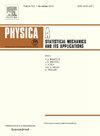Coupled vehicle-signal control based on Stackelberg Game Enabled Multi-agent Reinforcement Learning in mixed traffic environment
IF 2.8
3区 物理与天体物理
Q2 PHYSICS, MULTIDISCIPLINARY
Physica A: Statistical Mechanics and its Applications
Pub Date : 2025-01-15
DOI:10.1016/j.physa.2024.130289
引用次数: 0
Abstract
Related studies on traffic control in partially connected environments either did not consider the collaboration of traffic signal control and vehicular control, or did not consider others’ responsive actions before decision-making in coupled vehicle-signal control. Thus, we propose a Stackelberg Game Enabled Multi-agent Reinforcement Learning (SGMRL) method for coupled vehicle-signal control at an intersection with mixed traffic flow of Connected and Automated Vehicles (CAVs)/Human Driven Vehicles (HDVs). A two-stage framework is applied in SGMRL to learn optimal signal control strategy and CAV platoon strategies in mixed flows of all entrance roads at an intersection. Stackelberg game theory is introduced in SGMRL to make an asynchronous decision-making mechanism. The signal controller is a leader that allocates green times to different phases based on predictions of vehicles’ responsive actions, and CAVs in different directions are followers that form platoons and adjust speeds to adapt to the signal lights decided by the leader. Moreover, CAV platoons in different directions are regarded as agents and form a multi-agent learning framework with the signal controller. Then, an improved Dueling Double Deep Q Network (ID3QN) algorithm is investigated to calculate the Stackelberg equilibrium for the control problem. Experimental results demonstrate that the proposed model effectively reduces the overall waiting time and queue length of all vehicles, in the mixed traffic environment with different CAV penetration rates.
求助全文
约1分钟内获得全文
求助全文
来源期刊
CiteScore
7.20
自引率
9.10%
发文量
852
审稿时长
6.6 months
期刊介绍:
Physica A: Statistical Mechanics and its Applications
Recognized by the European Physical Society
Physica A publishes research in the field of statistical mechanics and its applications.
Statistical mechanics sets out to explain the behaviour of macroscopic systems by studying the statistical properties of their microscopic constituents.
Applications of the techniques of statistical mechanics are widespread, and include: applications to physical systems such as solids, liquids and gases; applications to chemical and biological systems (colloids, interfaces, complex fluids, polymers and biopolymers, cell physics); and other interdisciplinary applications to for instance biological, economical and sociological systems.

 求助内容:
求助内容: 应助结果提醒方式:
应助结果提醒方式:


